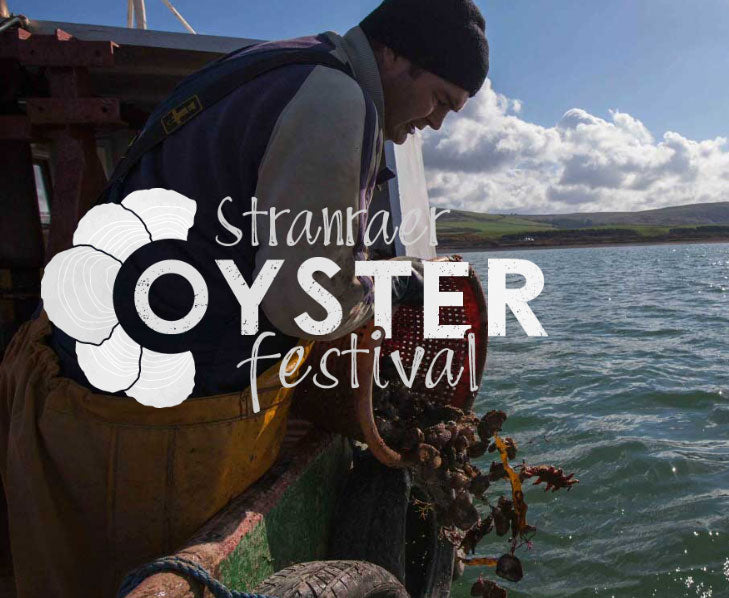
Scotland
The Loch Ryan Oyster Bed dates back to 1701, when King William III, granted a Royal Charter of the oyster bed to the Wallace family. The family live on the shores of the Loch, and the rights to the oysters bed have been in their family ever since.
Every September the town of Stranraer celebrates the start o the Loch Ryan Native Season with a three day festival. During 2024 this was filmed for the BBC, and you can view the Countryfile episode here.
-
Location of the beds
Loch Ryan is situated in South West Scotland, and the Loch itself is about 12Km long and 4Km wide, about 42 square km of seabed. It is Scotland’s largest native oyster bed. The oysters are fished from the seabed, by dredging them with our boat the Vital Spark. The Vital Spark is fishing most days the weather allows and the skipper John and his son Jordan crew the boat. A typical day would be to leave Stranraer harbour, at the south of the loch where the boat is moored, and steam up to the main oyster area on the east side of the Loch, near to Lefnoll Point, circled in red. Here the bottom is harder, and the shells sit well on the seabed, and they can be harvested quite well. The water movement on the east side of the Loch is much greater, and with this movement comes more food to help the oysters grow. The contents of the dredge is landed on the stern of the boat, and is hand sorted. The oysters are hand graded on the boat into three grades depending on their weight between 70-130g. Most days we are able to catch about 2,000 oysters, of these marketable oysters, but to find them we have to sift through 40,000 smaller ones that are too small. These oysters are the future of the bed, and they are densely re-laid into well marked beds. The benefit of relaying the oysters close together is that they are near to each other, so that in the summer months when they breed, there is much more chance that the male will be able to fertilise the female oysters’ eggs. -
Stock
When we took over the running of the bed in 1996, a survey showed that the total population of oysters in the Loch was thought to be around 1 million oysters. Through some careful management, and harvesting only the very largest for the market, we have been able to relay plenty of oysters for future years. These oysters will grow, and also be brood stock for about another 5 years or so, until they are harvested. The oysters grow at a rate of about 11g per year, so the by the time you serve an oyster, it is about 8 years old, much slower growing than the Rock Oyster. -
Summer breeding programme
We generally stop harvesting at the end of April or May which allow the oysters to breed. As the water becomes warmer, the oysters put their energy into the production of eggs or sperm. This takes quite a few weeks until the gonad is fully developed, and when the water temperature is up to 1 degrees or so, the males spawn, releasing their sperm into the water. These then are filtered by the females, and are captured in the gills of the oyster, where the sperm fertilise the eggs. Each oyster produces about a million larvae, and these are free swimming in the water, where they grow from about 1/4mm to 1/3mm in size, over a period of about 10 days. Naturally, during these days, the tide washes the larvae in and out, on every tide, but amazingly in Loch Ryan, some of the water is retained, and some larvae do survive and are able to settle on some shell on the seabed. We have had successful breeding most years, but some years, especially the hotter ones, we do manage to get a very good crop. This is the only oyster bed in Scotland that is self-sufficient, and by harvesting the oysters slowly, and replacing the small oysters into beds, we hope to build a larger population, which will then breed more, producing more to sell. -
The Oysters
The oysters have a thick shell, probably due to their slow growth, with a plump, almost crisp bite to them. They are salty, and have a nutty, real taste of the sea. -
Distribution of our oysters
We fish the oysters every day, and at the end of the day, the oysters are bagged up into mesh bags and stored on the foreshore. The oysters then “harden off” on the shore, and get used to being out of the water, on every tide, twice a day. This sort of teaches the oysters to be able to survive out of water better, which improves their shelf-life. Every week the oysters are packed into 25kg sacks and delivered overnight to our depot in West Sussex. -
Loch Ryan Water Quality
The water in Loch Ryan is of a very good quality. We have one main freshwater input from the Soleburn, which helps provide the nutrients the oysters need to grow. We are monitored on a monthly basis by the Food Standards Scotland, and the results are used to classify the water.

Stranraer Oyster Festival 12th - 14th September 2025
A three day celebration of the area's unique coastal heritage, its culture, its people and its fabulous wealth of local produce. Do join us in 2025!






